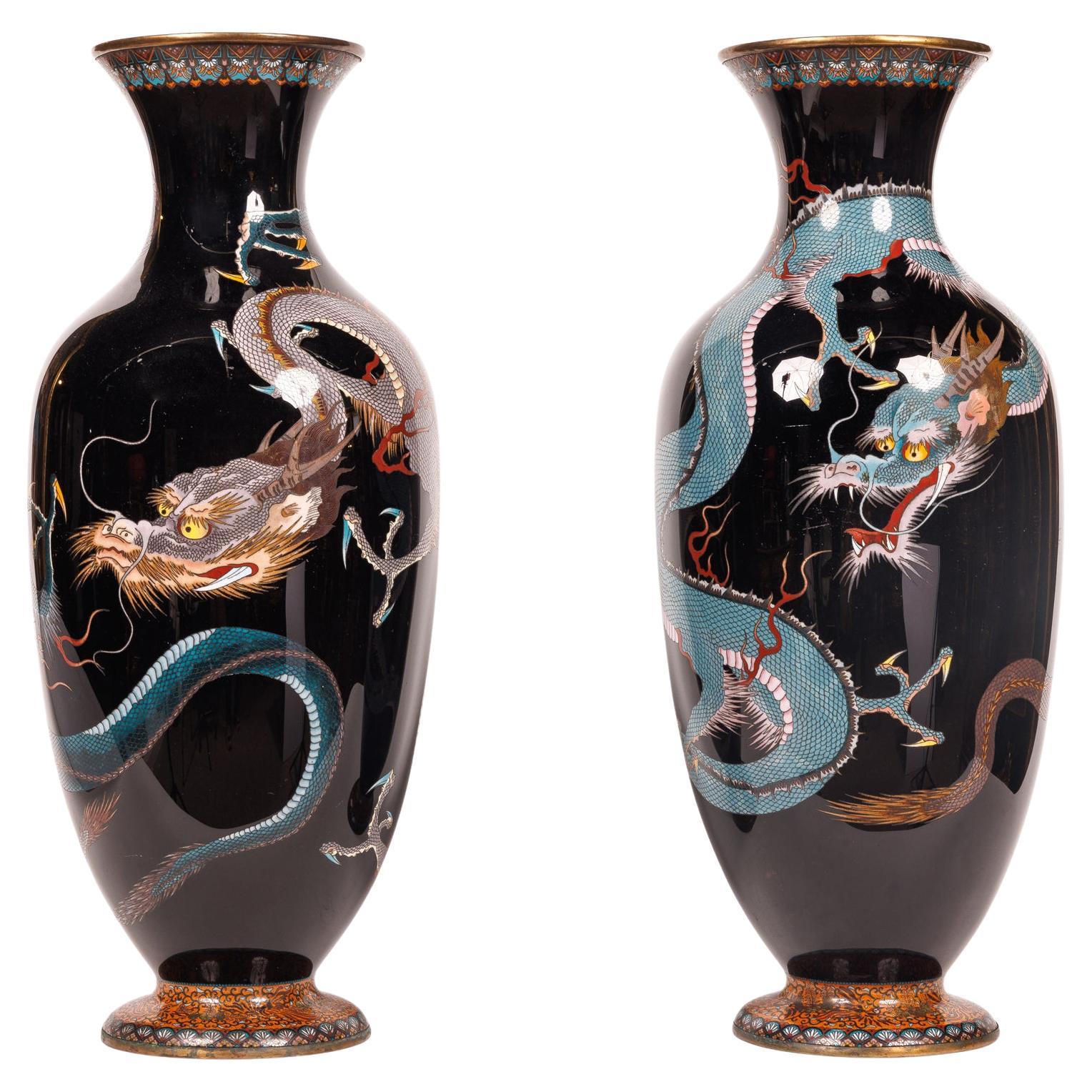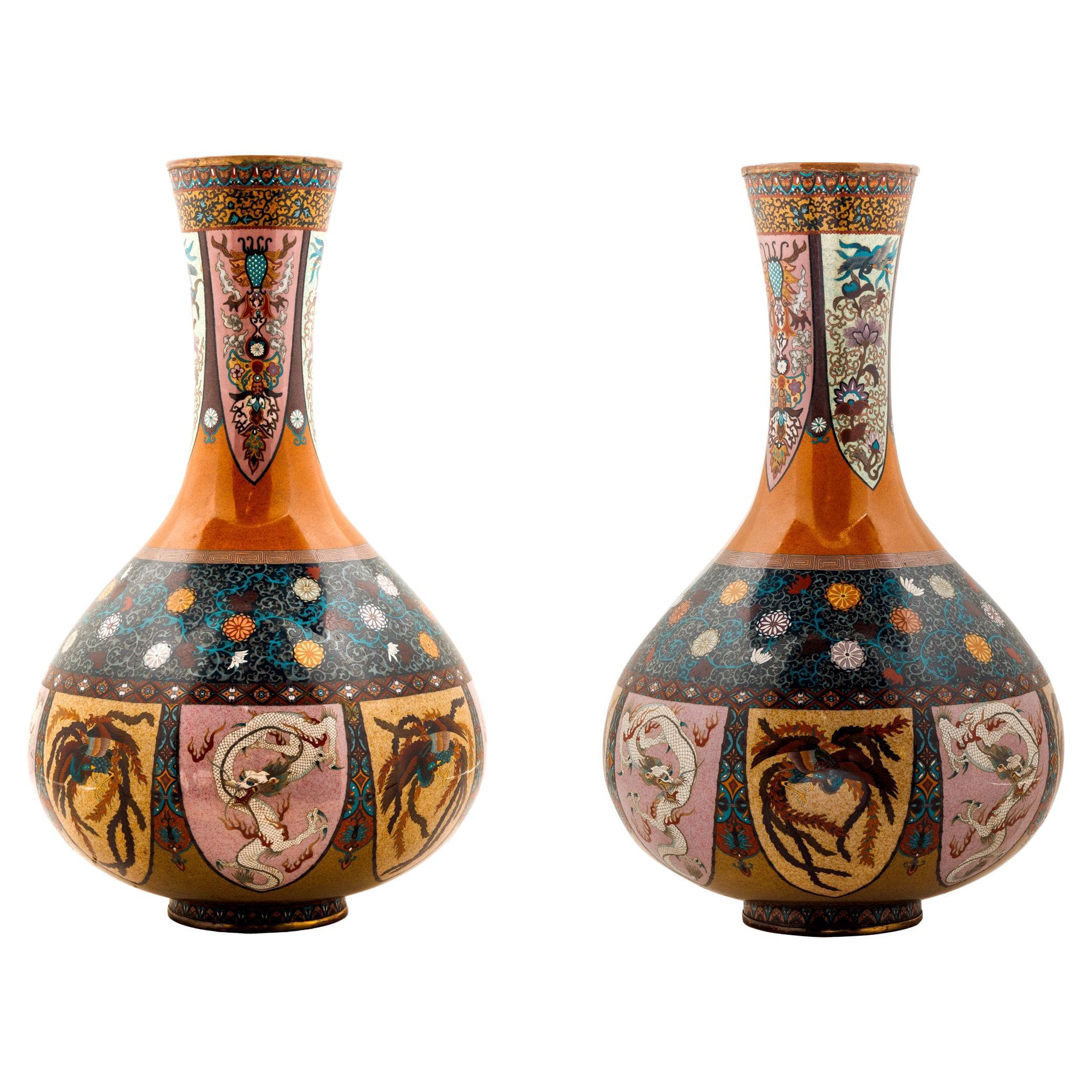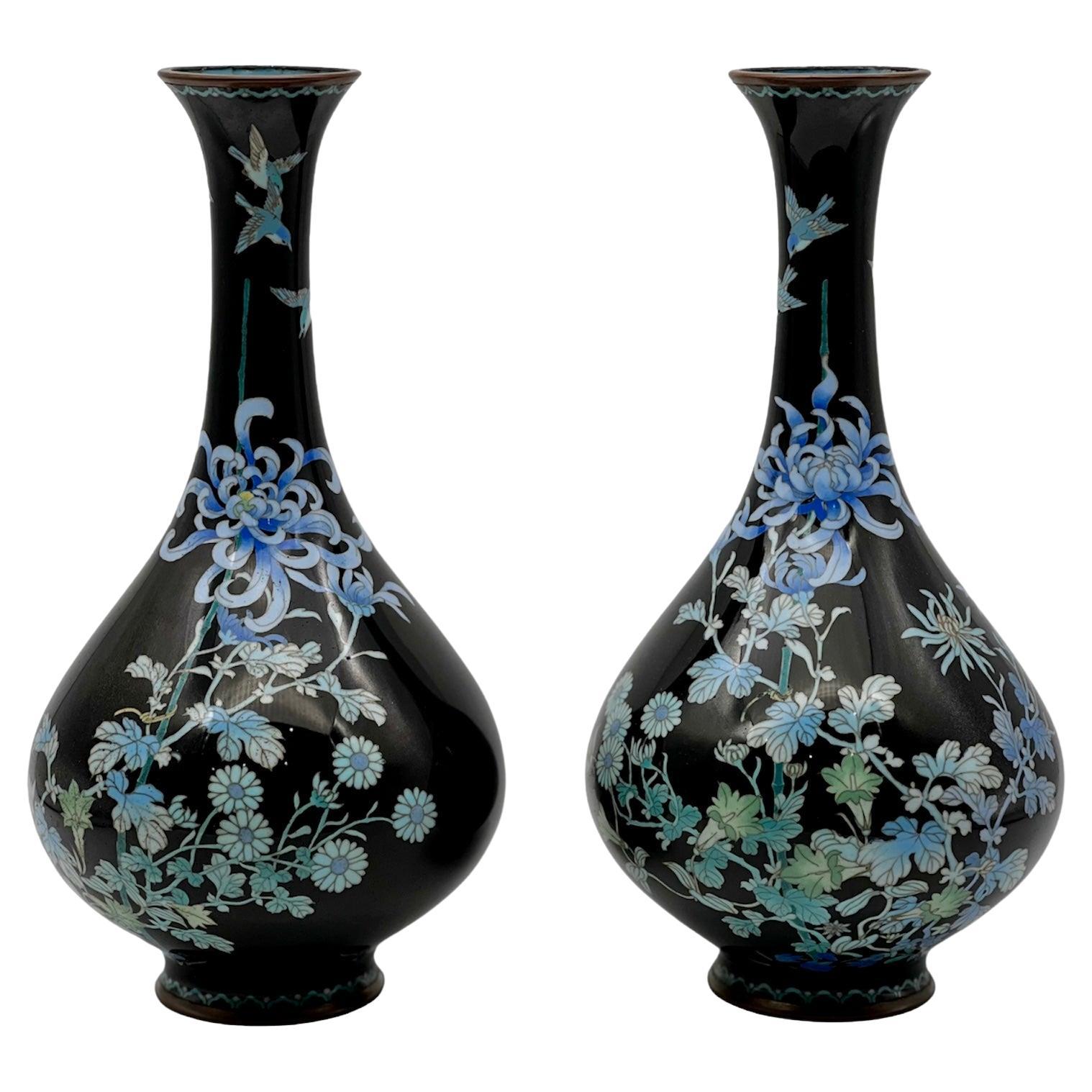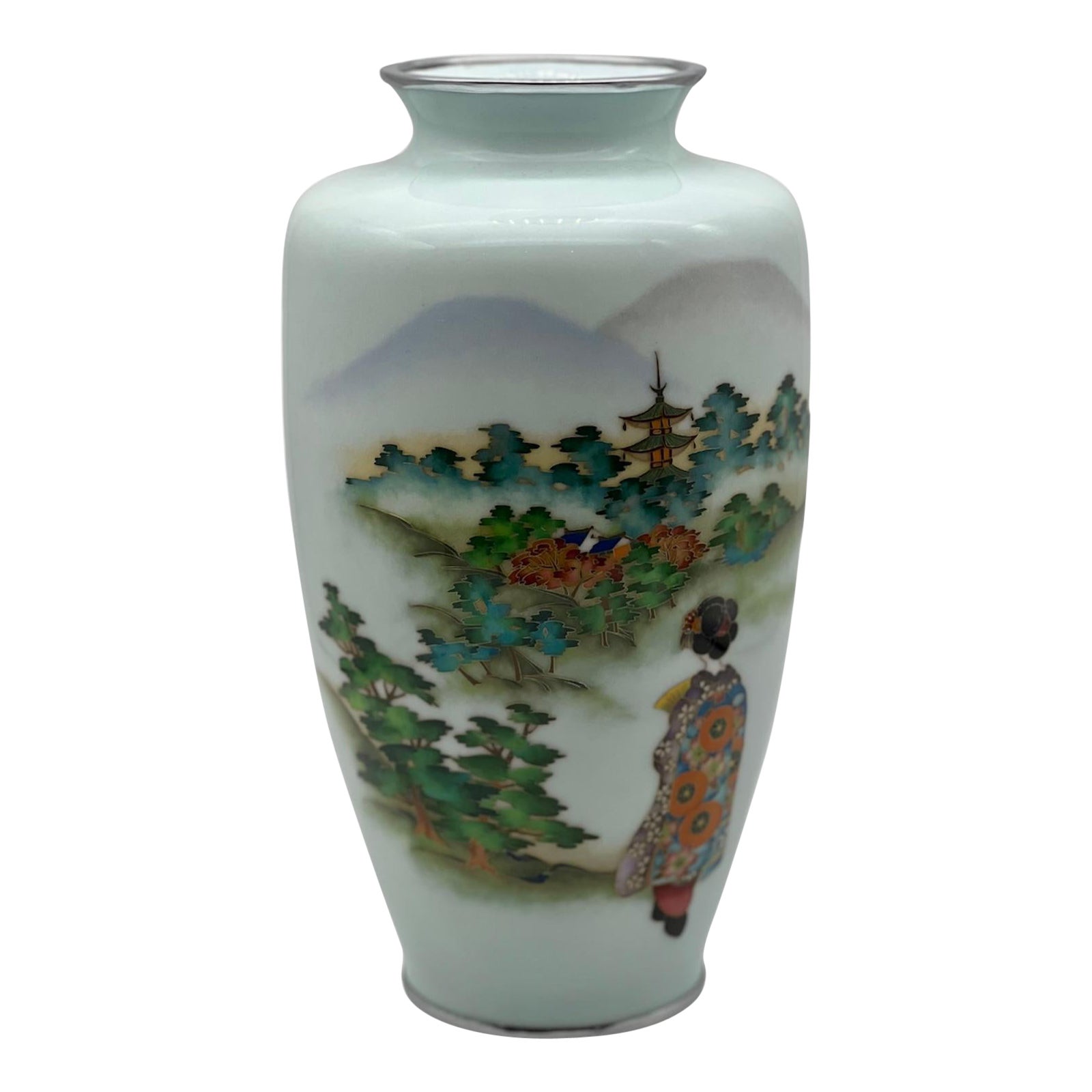Items Similar to Large Pair of Meiji Period Japanese Cloisonne Enamel Vases Attributed to Goto
Want more images or videos?
Request additional images or videos from the seller
1 of 20
Large Pair of Meiji Period Japanese Cloisonne Enamel Vases Attributed to Goto
About the Item
A large pair of Meiji Period Japanese cloisonne enamel vases attributed to Goto Seizaburo, 19th century.
These vases were made during the Meiji period (1868-1912) in Japan and are characterized by their blue enamel background with intricate designs of flowers, birds (including pigeons), butterflies and landscapes.
The use of blue enamel as a background creates a striking contrast with the colorful designs, making these vases particularly visually appealing which are appreciated for their beauty, craftsmanship, and cultural significance.
Goto Seizaburo (1852-1914) was a renowned Japanese cloisonne enamel artist who lived and worked during the Meiji period (1868-1912). He was born in Nagoya and started his career as an apprentice to a local cloisonne enamel artist. He later moved to Tokyo and began working for the Ando Cloisonne Company.
Goto Seizaburo was known for his exceptional skill and attention to detail in cloisonne enamel. He developed new techniques, including the use of transparent enamel, and created intricate designs that often featured flowers, birds, and other natural elements.
His works were highly sought after by collectors and were exhibited at international exhibitions, including the Paris Universal Exposition in 1900, where he won a Gold Medal. He also received numerous awards and honors in Japan for his contributions to the art of cloisonne enamel.
Today, Goto Seizaburo is considered one of the most important cloisonne enamel artists of the Meiji period, and his works continue to be highly valued and collected by art enthusiasts and collectors around the world.
Good condition overall, no damaged noted. A minor flake to the enamel in one area.
Measures : 18.5" high x 9" diameter.
- Dimensions:Height: 18.5 in (46.99 cm)Diameter: 9 in (22.86 cm)
- Style:Meiji (Of the Period)
- Materials and Techniques:
- Place of Origin:
- Period:
- Date of Manufacture:19th Century
- Condition:Wear consistent with age and use.
- Seller Location:New York, NY
- Reference Number:1stDibs: LU1798233534832
About the Seller
5.0
Vetted Seller
These experienced sellers undergo a comprehensive evaluation by our team of in-house experts.
Established in 1980
1stDibs seller since 2016
58 sales on 1stDibs
Typical response time: <1 hour
- ShippingRetrieving quote...Ships From: New York, NY
- Return PolicyThis item cannot be returned.
More From This SellerView All
- Large Pair of Meiji Period Japanese Cloisonne Enamel Double Dragon VasesLocated in New York, NYA large pair of Meiji Period Japanese Cloisonne Enamel Double Dragon Vases, 19th century. Japanese cloisonne enamel dragon vases are highly ...Category
Antique 19th Century Japanese Meiji Metalwork
MaterialsCopper, Enamel
- Large Pair of Japanese Cloisonne Enamel Vases Attributed to Honda YasaburoLocated in New York, NYA large pair of Japanese Cloisonne Enamel vases attributed to Honda Yasaburo, 19th century. Finley decorated with the rich enamel colors of orange and green, these vases are desig...Category
Antique 19th Century Japanese Meiji Metalwork
MaterialsCopper, Enamel
- Large Pair of Japanese Cloisonne Enamel Lanterns Attributed to Kaji TsunekichiLocated in New York, NYA Large Pair of Japanese Cloisonne Enamel Lanterns Attributed to Kaji Tsunekichi, Edo Period, 19th century Japanese cloisonne lanterns were made during the Meiji period, from the late 19th to early 20th century, and were often used as decorative lighting fixtures in temples and shrines. Kaji Tsunekichi (1866-1916) was a Japanese cloisonné artist who was active in the late 19th and early 20th centuries. He was born in Tokyo and learned the art of cloisonné from his father, Kaji Sataro, who was also a cloisonné artist. He was renowned for his mastery of the shippo-yaki technique, which involves creating intricate designs with thin wires on a metal base before filling in the spaces with enamel. Tsunekichi was known for his exceptional technical skills and his ability to create intricate designs with vibrant colors. His works often featured nature motifs, such as flowers, birds, and fish, which were rendered in a highly detailed and naturalistic style. He also experimented with new techniques, such as plique-à-jour, a type of cloisonné that creates a stained-glass effect. Tsunekichi's works were highly prized during his lifetime and continue to be sought after by collectors today. He won numerous awards for his cloisonné creations, including a Gold Medal at the 1900 Exposition Universelle in Paris. His works are characterized by their fine wirework, precise enamel application, and attention to detail. Some of Tsunekichi's most famous works include a pair of large cloisonné vases...Category
Antique 19th Century Japanese Edo Metalwork
MaterialsCopper, Enamel
- An Exquisite Pair Of Japanese Cloisonné Enamel Vases with Chrysanthemum BlossomsLocated in New York, NYAn Exquisite Pair Of Japanese Cloisonné Enamel Vases with Chrysanthemum Blossoms, Attributed to Hayashi, Meiji Period. Experience the exquisite craftsmanship of the Meiji period wit...Category
Antique 19th Century Japanese Meiji Metalwork
MaterialsEnamel
- Large Meiji Period Japanese Cloisonne Enamel Vase Adorned with Iris BlossomsLocated in New York, NYIntroducing a magnificent Large Meiji Period Japanese Cloisonné Enamel Vase adorned with enchanting iris blossoms. This extraordinary vase encapsulates the essence of Japanese artist...Category
Antique 19th Century Japanese Meiji Vases
MaterialsEnamel
- Monumental Meiji Period Japanese Cloisonne Enamel JardiniereLocated in New York, NYA Monumental Meiji Period Japanese Cloisonne Enamel Jardiniere. This monumental Meiji Period Japanese cloisonne enamel jardiniere is...Category
Antique 19th Century Japanese Meiji Planters, Cachepots and Jardinières
MaterialsEnamel, Copper
You May Also Like
- A Fine Pair Pair of Japanese Cloisonne Enamel Oviform Vases. Meiji period.Located in London, GBA Magnificent Pair of Japanese Cloisonne Enamel Oviform Vases 19th Century Meiji period A Pair of Japanese cloisonné enamel oviform vases worked with silver wire and decorated wit...Category
Antique Late 19th Century Japanese Metalwork
MaterialsEnamel
- Large Meiji Period Cloisonne Enamel KoroLocated in London, GBLarge Meiji Period Cloisonne Enamel Koro Japanese, late 19th Century Height 88cm, width 76cm, depth 53cm This superb cloisonne enamel koro was made during Japan's Meiji period, and ...Category
Antique Late 19th Century Japanese Meiji Metalwork
MaterialsBronze, Enamel
- A Large Japanese Cloisonne Enamel vase attributed to Ando JubeiBy Ando JubeiLocated in London, GBA Large Japanese Cloisonne Enamel vase attributed to Ando Jubei. Taisho period (1912 – 1926) A large baluster Cloisonne-Enamel vase worked in musen and silver wire of varying gauge...Category
Early 20th Century Japanese Metalwork
MaterialsEnamel
- A Fine Japanese Cloisonne Enamel Vase and Cover. Meiji PeriodLocated in London, GBA Exquisite Cloisonne Enamel Vase and cover Meiji period -Late 19th C Exquisite and refined four sided cloisonne vase and cover made in gold and silver wire with dragons and phoen...Category
Antique Late 19th Century Japanese Metalwork
MaterialsEnamel
- A Fine Pair of Japanese Cloisonne Enamel Vases Attributed to Hayashi KodenjiLocated in London, GBA Exquisite Pair of Japanese Cloisonne Enamel Vases Attributed to Hayashi Kodenji. Meiji period 19th Century A Fine Pair of Japanese cloisonné ename...Category
Antique Late 19th Century Japanese Metalwork
MaterialsEnamel
- Antique Very Large Pair of Japanese Bronze Vases Meiji PeriodLocated in Wisbech, CambridgeshireAntique very large pair of fine quality Japanese bronze vases C1910 Meiji Period. Would look amazing in the right location. Rare large size and design. Overall maximum dimensi...Category
Vintage 1910s Japanese Meiji Metalwork
MaterialsBronze
Recently Viewed
View AllMore Ways To Browse
Period Japanese
Japanese Works Of Art
Japanese Company
Antique Collectors And Period Furniture
Copper Art Pair
Local Asian Furniture
Meiji Pair
Antique Enamel Company
Cloisonne Enamel Vase
Meiji Enamel
Japanes Cloisonne
Japanese Cloisonne
Japan Cloisonne
Paris 1912
Copper Background
Japanese Birds Pairs
Antique Japanese Cloisonne
Large Cloisonne





